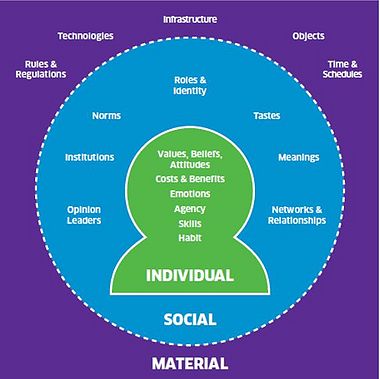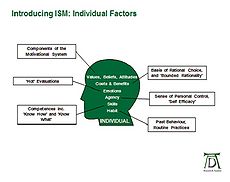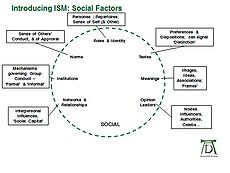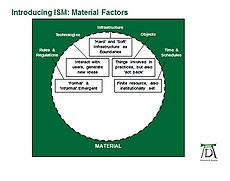ISM Principles of Change
| Line 1: | Line 1: | ||
[[File:ISM.jpg|thumb|right|380px|The ISM - Individual, Social, and Material - model. A technical model to understand and influence behaviours [ISBN: 978-1-78256-566-6 (web only) ''INFLUENCING BEHAVIOURS - A technical guide to the ISM tool.'' [https://www.ismtool.org/ ''ISM tool'']]] | [[File:ISM.jpg|thumb|right|380px|The ISM - Individual, Social, and Material - model. A technical model to understand and influence behaviours [ISBN: 978-1-78256-566-6 (web only) ''INFLUENCING BEHAVIOURS - A technical guide to the ISM tool.'' [https://www.ismtool.org/ ''ISM tool'']]] | ||
| − | The ISM - Individual, Social, and Material - model is a multi-disciplinary tool to study the human behavior in the aspects of: behavioral economics, social psychology and sociology <ref>''Technical Guide'', Darnton, A., Evans, D., (2013), Influencing Behaviour - A technical guide to the ISM tool. Scottish Government. </ref>. Based on theory and evidence, the contexts of the individual, the social, and the material have essential impact on human behaviour. The ISM model facilitates an integrated, whole-system perspective around these three contexts to highlight challenges of individuals, organizations, and partnerships. Through the process, stakeholders aim to develop a shared understanding by identifying their respective roles in bringing about change. Hereby, the model draws insight from multiple disciplines to ease the decision-making of complex problems. The result is a shared ownership of solutions. This is a vital part of programme management to successfully transferring ownership to operations in interrelated projects <ref>''Book'', Jarocki, T. L. (2014), One Solution for Project Success: Project and Change Management in the PMBOK® Guide. PMI White Paper. Retreived from https://www.pmi.org/learning/library/one-solution-project-success-11130</ref>. The model can also be applied to understand and manage stakeholders in specific projects. Nonetheless, human behaviour is vital in management while misunderstandings of this subject can be fatal <ref>''Journal'', Baraza, A. O., (2017), Influence of Human Behavior on Success of Complex Public Infrastructural Megaprojects in Kenya. European Scientific Journal. 13. </ref>. | + | The ISM - Individual, Social, and Material - model is a multi-disciplinary tool to study the human behavior in the aspects of: behavioral economics, social psychology and sociology <ref name="TechISO">''Technical Guide'', Darnton, A., Evans, D., (2013), Influencing Behaviour - A technical guide to the ISM tool. Scottish Government. </ref>. Based on theory and evidence, the contexts of the individual, the social, and the material have essential impact on human behaviour. The ISM model facilitates an integrated, whole-system perspective around these three contexts to highlight challenges of individuals, organizations, and partnerships. Through the process, stakeholders aim to develop a shared understanding by identifying their respective roles in bringing about change. Hereby, the model draws insight from multiple disciplines to ease the decision-making of complex problems. The result is a shared ownership of solutions. This is a vital part of programme management to successfully transferring ownership to operations in interrelated projects <ref>''Book'', Jarocki, T. L. (2014), One Solution for Project Success: Project and Change Management in the PMBOK® Guide. PMI White Paper. Retreived from https://www.pmi.org/learning/library/one-solution-project-success-11130</ref>. The model can also be applied to understand and manage stakeholders in specific projects. Nonetheless, human behaviour is vital in management while misunderstandings of this subject can be fatal <ref>''Journal'', Baraza, A. O., (2017), Influence of Human Behavior on Success of Complex Public Infrastructural Megaprojects in Kenya. European Scientific Journal. 13. </ref>. |
The ISM tool was developed by researcher Andrew Darnton and launched by the Scottish Government in 2013 to evaluate the impact of sustainability challenges in interrelated projects. Since, it has found use for policy makers and practitioners to influence people's behaviors and bring about change <ref>''Conference'', Darnton, A. (2016), Developing behaviour change campaigns conference, https://www.slideshare.net/CharityComms/understanding-behaviour-change-in-context-developing-behaviour-change-campaigns-conference-14-july-2016</ref>. The combination of theoritical and practical aspects of the ISM model is tailored to design or improve programmes, which are utilized in many cases such as waste management, lower carbon emissions, and policy processes. Hence, the applicability of ISM can be used to influence behaviour in the path to implement change through interrelated projects. | The ISM tool was developed by researcher Andrew Darnton and launched by the Scottish Government in 2013 to evaluate the impact of sustainability challenges in interrelated projects. Since, it has found use for policy makers and practitioners to influence people's behaviors and bring about change <ref>''Conference'', Darnton, A. (2016), Developing behaviour change campaigns conference, https://www.slideshare.net/CharityComms/understanding-behaviour-change-in-context-developing-behaviour-change-campaigns-conference-14-july-2016</ref>. The combination of theoritical and practical aspects of the ISM model is tailored to design or improve programmes, which are utilized in many cases such as waste management, lower carbon emissions, and policy processes. Hence, the applicability of ISM can be used to influence behaviour in the path to implement change through interrelated projects. | ||
| Line 18: | Line 18: | ||
The ISM tool was originally created in 2011 at the University of Manchester to map and influence people's behaviour towards sustainability challenges <ref>''Journal'', Southerton, D., Díaz-Méndez, C., & Warde, A. (2011), Behavioural Change and the Temporal Ordering of Eating Practices. International Journal of Sociology of Agriculture and Food. 19. 19-36. </ref>. In this relation, Andrew Darnton further developed and standardized the ISM classification model in 2013 to cover policy interventions and programme management. The development was based on research and ongoing projects on human behaviour towards sustainability change <ref>''Journal'', Cox, A., Higgins, T., Gloster, R., Foley, B., Darnton, A. (2012), The Impact of Workplace Initiatives on Low Carbon Behaviours. Scottish Government </ref>. Herein, the theoritical contexts were justified in the International Review of Behaviour Change Initiatives <ref>''Journal'', Southerton, D., McMeekin, A., & Evans, D. (2012), International Review of Behaviour Change Initiatives. Scottish Government </ref>. Therefore, the ISM tool is considered to be an all-in-one practical alternative to existing behavioural models by bringing together multiple disciplines. | The ISM tool was originally created in 2011 at the University of Manchester to map and influence people's behaviour towards sustainability challenges <ref>''Journal'', Southerton, D., Díaz-Méndez, C., & Warde, A. (2011), Behavioural Change and the Temporal Ordering of Eating Practices. International Journal of Sociology of Agriculture and Food. 19. 19-36. </ref>. In this relation, Andrew Darnton further developed and standardized the ISM classification model in 2013 to cover policy interventions and programme management. The development was based on research and ongoing projects on human behaviour towards sustainability change <ref>''Journal'', Cox, A., Higgins, T., Gloster, R., Foley, B., Darnton, A. (2012), The Impact of Workplace Initiatives on Low Carbon Behaviours. Scottish Government </ref>. Herein, the theoritical contexts were justified in the International Review of Behaviour Change Initiatives <ref>''Journal'', Southerton, D., McMeekin, A., & Evans, D. (2012), International Review of Behaviour Change Initiatives. Scottish Government </ref>. Therefore, the ISM tool is considered to be an all-in-one practical alternative to existing behavioural models by bringing together multiple disciplines. | ||
| − | Since its creation, the success of the model has resulted in a technical guide, published by the Scottish Government, and nominated as the tool of choice to implement behavioural change <ref | + | Since its creation, the success of the model has resulted in a technical guide, published by the Scottish Government, and nominated as the tool of choice to implement behavioural change <ref name="TechISO"/>. Moreover, the ISM concept has been mandated all public institutions in Scotland in order to meet certain Carbon budgets. The areas include health care, local authorities, DEFRA, the NUS, the Scottish Natural Heritage, and diverse community groups amongst others. |
== The Three Aspects == | == The Three Aspects == | ||
Revision as of 21:05, 25 February 2021

The ISM - Individual, Social, and Material - model is a multi-disciplinary tool to study the human behavior in the aspects of: behavioral economics, social psychology and sociology [1]. Based on theory and evidence, the contexts of the individual, the social, and the material have essential impact on human behaviour. The ISM model facilitates an integrated, whole-system perspective around these three contexts to highlight challenges of individuals, organizations, and partnerships. Through the process, stakeholders aim to develop a shared understanding by identifying their respective roles in bringing about change. Hereby, the model draws insight from multiple disciplines to ease the decision-making of complex problems. The result is a shared ownership of solutions. This is a vital part of programme management to successfully transferring ownership to operations in interrelated projects [2]. The model can also be applied to understand and manage stakeholders in specific projects. Nonetheless, human behaviour is vital in management while misunderstandings of this subject can be fatal [3].
The ISM tool was developed by researcher Andrew Darnton and launched by the Scottish Government in 2013 to evaluate the impact of sustainability challenges in interrelated projects. Since, it has found use for policy makers and practitioners to influence people's behaviors and bring about change [4]. The combination of theoritical and practical aspects of the ISM model is tailored to design or improve programmes, which are utilized in many cases such as waste management, lower carbon emissions, and policy processes. Hence, the applicability of ISM can be used to influence behaviour in the path to implement change through interrelated projects.
Contents |
Background
Traditional behavioural models tend to evaluate human behaviour by focusing on the factors separately. However, studies show that human behaviour depends on a combination of several interrelated factors [xx]. The most essential factors are related to the individual, its society, and the surrounding material. A cross-consideration of all three factors increase the chance of success to understand and manipulate human behaviour. The ISM model relies on this concept.
The ISM tool was originally created in 2011 at the University of Manchester to map and influence people's behaviour towards sustainability challenges [5]. In this relation, Andrew Darnton further developed and standardized the ISM classification model in 2013 to cover policy interventions and programme management. The development was based on research and ongoing projects on human behaviour towards sustainability change [6]. Herein, the theoritical contexts were justified in the International Review of Behaviour Change Initiatives [7]. Therefore, the ISM tool is considered to be an all-in-one practical alternative to existing behavioural models by bringing together multiple disciplines.
Since its creation, the success of the model has resulted in a technical guide, published by the Scottish Government, and nominated as the tool of choice to implement behavioural change [1]. Moreover, the ISM concept has been mandated all public institutions in Scotland in order to meet certain Carbon budgets. The areas include health care, local authorities, DEFRA, the NUS, the Scottish Natural Heritage, and diverse community groups amongst others.
The Three Aspects
The ISM connects three main theories in behavioural science, which are behavioural economics, social psychology, and sociology, in one single illustration, depicted in the ISM model. The theories are expressed within the context of three symbols: 1) a head (the indivual), 2) a circle (the social), and 3) a square (the material). All three contexts contain factors that must be considered to succesfully evoke behavioural change as defined below by the creator Andrew Darnton [XX]:
The ISM model starts from an understanding of individual behaviour, but sets that within its social and material contexts, illustrating how action on multiple levels by multiple actors is required for inclusive and lasting change.
The factors of each context can both constrain and shape human behaviours. The ISM model contains 18 main factors. These are all of high importance to understand and impact human behaviour changes. Therefore, the ISM model is tailored to impact decision-making, which is vital in management.
Individual

The individual context concerns the factors that individuals have an impact on, herein, the behaviours of individuals that affect decision-making. The behaviour of individuals arise from both from personal aspects such as attitudes, values, and skills but also more rational considerations such as cost and benefits. These aspects are elaborated into sense of control, competencies, past behaviour, and rational choices.
Values;
Beliefs;
Attitudes;
Costs & Benefits;
Emotions;
Agency;
Skills;
Habit;
Social

The social context contains factors of society that highly affect the human behaviour. The influences of social factors often stem from a shared understandings amongst groups, which can be a result of social norms, opinions, or networks. However, factors can also be inflicted from institutions to influence the behaviour. Hence, the aspects of social influences must be considered to understand human behaviour. It is worth noting that the factors within the ISM classification are not arranged hierarchically in terms of importance. All factors must be considered to fully understand and change human behaviour.
Roles & Identity;
Norms;
Tastes;
Institutions;
Meanings;
Networks & Relationships;
Opinion Leaders.
Considering the social factors together with the factors of the individual provides a better understand of human behaviour in terms of deliberation.
Material

The material context is about the influence of outside factors. These factors are a part of the daily life of individuals, which to an high extent are considered to have a constant impact in society. Such aspects include objects, infrastructure, rules, regulations, and time.
Infrastructure;
Technologies;
Objects;
Rules & Regulations;
Time & Schedules
Theoretical background
The justification of the ISM concept relies on the most prominent practical disciplines of human behaviour; behavioural economics, social psychology and sociology. The individual, social, and material contexts draw influences from all three disciplines combined, which keeps the ISM model relevant in any society at any time. In management of individuals or groups such cross-combinations are of high importance to emphasize with people's interests. Studies show that the majority of failed project and programme management tend to lack in one or more disciplines when communicating with stakeholders [xx].
Behavioural economics [1]
The study of behavioural economics analyzes the decision-making of a centralized individual or groups. The concerned effects of emotional, cultural, and social factors are considered. Within this aspect, the traditional representation covers a rational individual who operates to maximise its own interest. The decision-makings of the individual are based on rational factors such as cost-benefit calculations while it also consider heuristics, which describes the shortcuts in reaching decisions. While the former is typical for a rational individual, the latter tends to decrease the success of decision-making.
In general, managers must be aware of these different types of behaviours to successfully manage individuals, teams, or stakeholders in a desired direction. Especially in interrelated projects, like programmes, it is essential to understand the behavioural economics of the relevant stakeholders when introducing change in complex projects. To ease the handling of such processes, the Nudge theory can be applied to propose positive reinforcement.
Social psychology [2]
In social psychology, behaviours are understood as choices of the individual. However, the individual is highly impacted by social norms, roles, and relations, hence, it operates as a part of (or against) the collective. Within the collective exists attitudes, opinions, and identities that are affected by emotions as much as cold calculus and peer-pressure. These factors must be considered within the social psychology aspect to impact behaviours, and ultimately change.
The knowledge of social psychology is already employed in areas of marketing and management. The former utilizes this aspect of human behaviour to target desired clients, while the latter makes more influental leaders by including the interest of the majority [].
The combination of behavioural economics and social psycholgy can address challenges in a convincing manner to a large audience. However, a practical aspect must be included as well to implement a lasting change in behaviour. Such practices can be found in sociology.
Sociology [3]
x
The total combination of the disciplines provides a solid theoritical background that covers human behaviour to a large extent as it includes different view of human conduct. Similarly to the factors of ISM, it is worth noting that the theoritical disciplines must all be considered in the study of human behaviour. Relevant literature must be considered to fully understand each discipline and ultimately the theory of human behaviour as the disciplines are only introduced here. [EXAMPLES....] - include in bibliography/further readings
ISM in practice
intro:
Step-by-step approach
x
Examples of use
x
Limitations
x
Further reading
It fosters identification and development of options and shared ownership of solutions, taking account of influences on behaviors and decision-making which ultimately determine the impact of projects and actions.
Further readings:
PMI:
Behavioral economics: Nudge, R. H. Thaler.
Social psychology: Influence Science and Practice, R. B. Cialdini.
Sociology: The dynamics of social practice, E. Shove.
References
- ↑ 1.0 1.1 Technical Guide, Darnton, A., Evans, D., (2013), Influencing Behaviour - A technical guide to the ISM tool. Scottish Government.
- ↑ Book, Jarocki, T. L. (2014), One Solution for Project Success: Project and Change Management in the PMBOK® Guide. PMI White Paper. Retreived from https://www.pmi.org/learning/library/one-solution-project-success-11130
- ↑ Journal, Baraza, A. O., (2017), Influence of Human Behavior on Success of Complex Public Infrastructural Megaprojects in Kenya. European Scientific Journal. 13.
- ↑ Conference, Darnton, A. (2016), Developing behaviour change campaigns conference, https://www.slideshare.net/CharityComms/understanding-behaviour-change-in-context-developing-behaviour-change-campaigns-conference-14-july-2016
- ↑ Journal, Southerton, D., Díaz-Méndez, C., & Warde, A. (2011), Behavioural Change and the Temporal Ordering of Eating Practices. International Journal of Sociology of Agriculture and Food. 19. 19-36.
- ↑ Journal, Cox, A., Higgins, T., Gloster, R., Foley, B., Darnton, A. (2012), The Impact of Workplace Initiatives on Low Carbon Behaviours. Scottish Government
- ↑ Journal, Southerton, D., McMeekin, A., & Evans, D. (2012), International Review of Behaviour Change Initiatives. Scottish Government